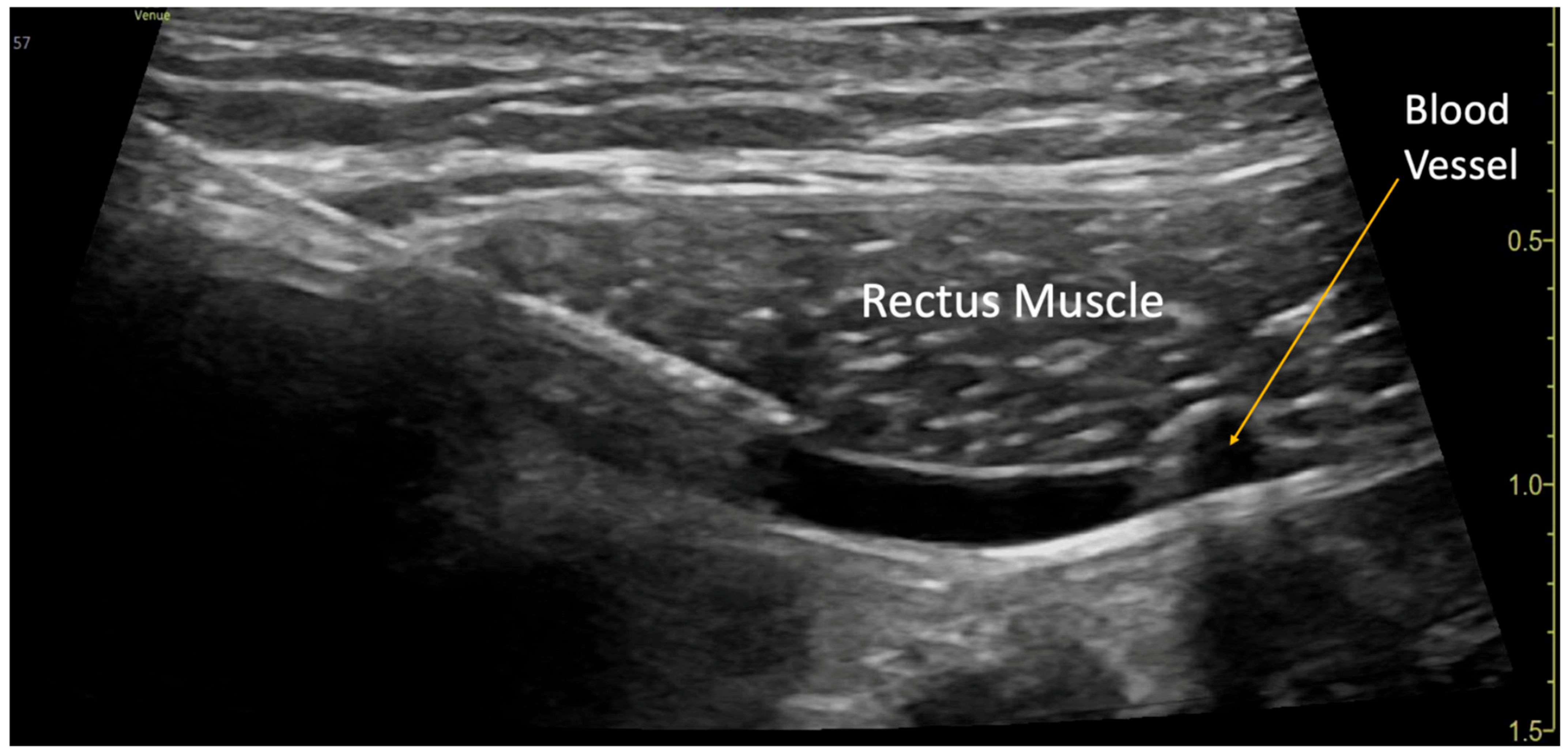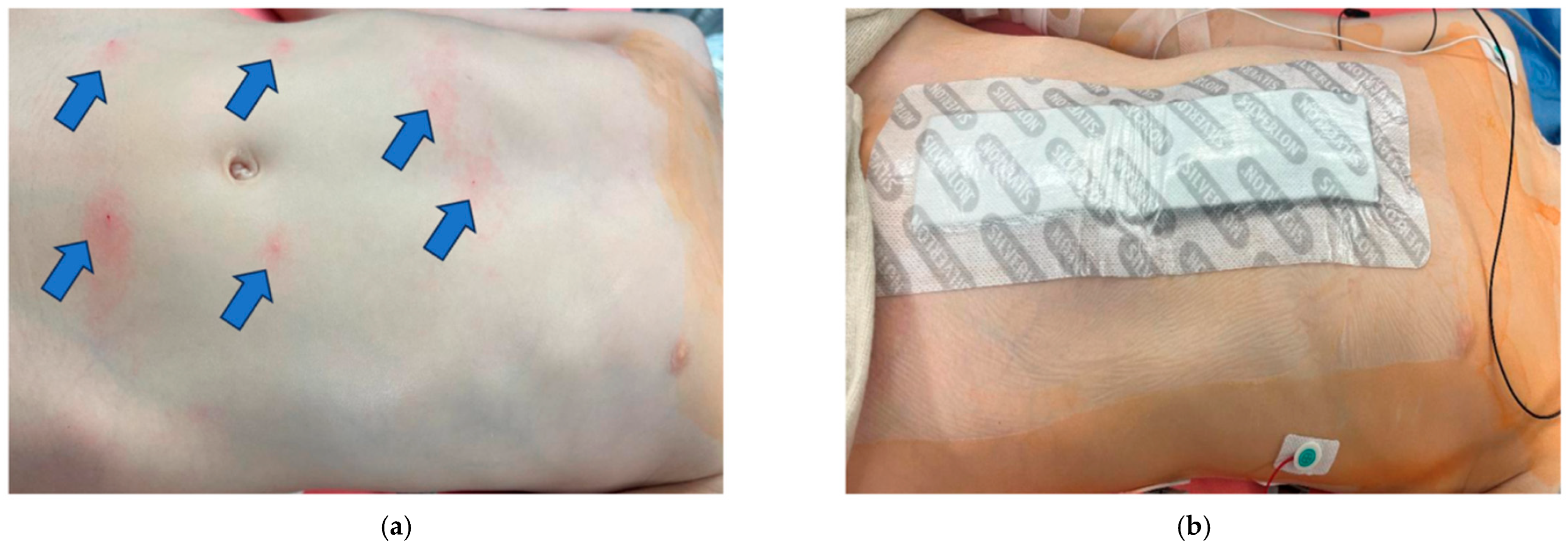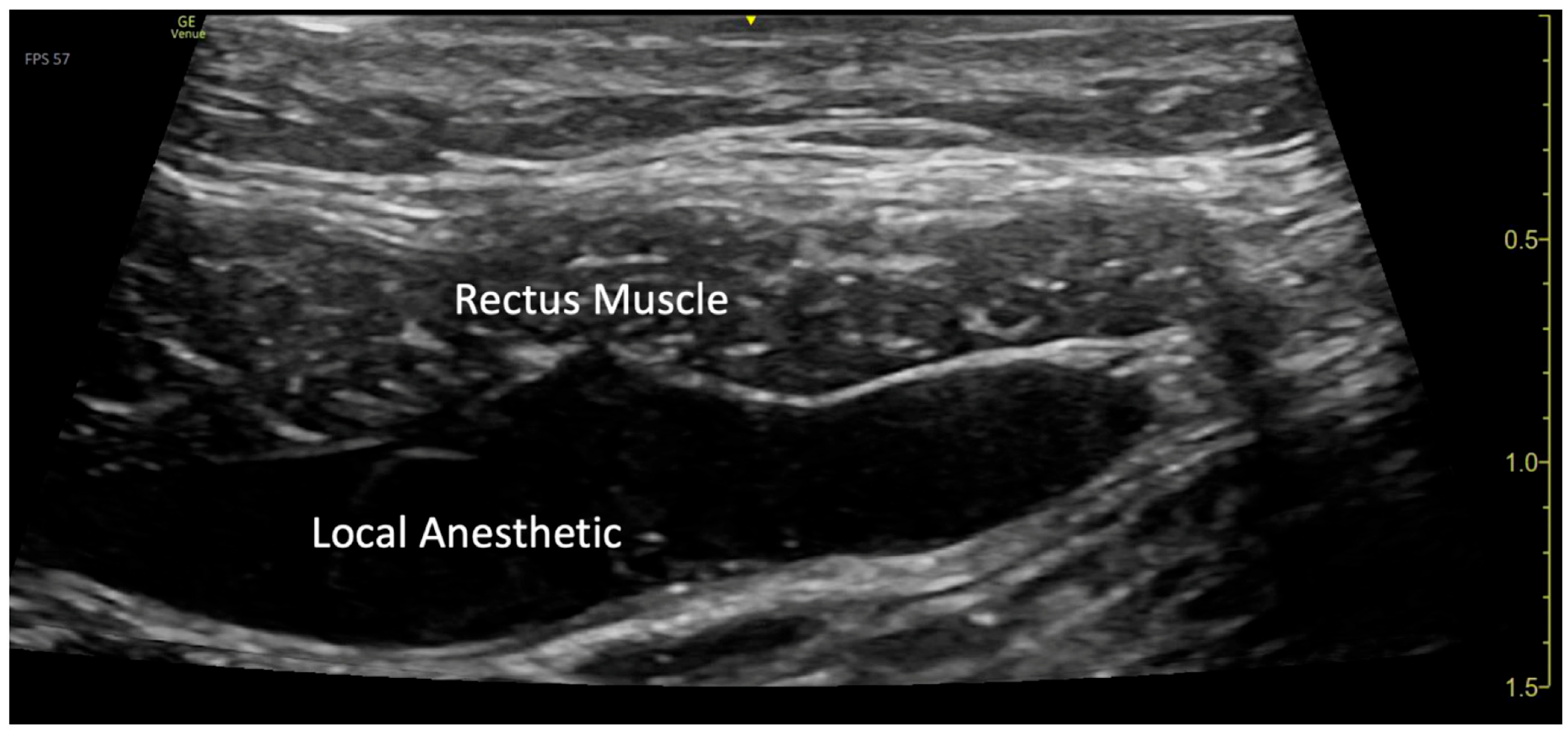Ultrasound-Guided Multilevel Bilateral Rectus Sheath Blocks with Liposomal Bupivacaine, Bupivacaine, and Dexamethasone PF for Postoperative Pain Management After a Pediatric Abdominal Aortic Aneurysm Repair
Highlights
- •
- Ultrasound-guided multilevel bilateral rectus sheath blocks utilizing a combination of liposomal bupivacaine, bupivacaine, and dexamethasone PF provided prolonged, opioid-sparing analgesia following open pediatric AAA repair.
- •
- There was no evidence of local anesthetic systemic toxicity observed in association with this analgesic approach.
- •
- This multilevel rectus sheath block technique (using liposomal bupivacaine, bupivacaine, and dexamethasone PF) may represent a safe and effective alternative to neuraxial techniques for complex pediatric abdominal surgery.
- •
- It is particularly relevant for patients in whom anticoagulation therapy or the need for neurologic monitoring makes epidural or paravertebral blocks a high-risk option.
Abstract
1. Introduction
2. Case Description
3. Discussion
4. Conclusions
Supplementary Materials
Author Contributions
Funding
Institutional Review Board Statement
Informed Consent Statement
Data Availability Statement
Conflicts of Interest
Abbreviations
| AAA | Abdominal aortic aneurysm |
| PF | Preservative-free |
| RSB | Rectus sheath block |
| POD | Postoperative day |
| IV | Intravenous |
| NPO | Nil per os |
| TAP | Transversus abdominus plane |
References
- Kontopodis, N.; Gavalaki, A.; Galanakis, N.; Kantzas, M.; Ioannou, C.; Geroulakos, G.; Kakisis, J.; Antoniou, G.A. Systematic Review With Meta-Analysis of Endovascular Versus Open Repair of Abdominal Aortic Aneurysm Repair in the Young. J. Endovasc. Ther. 2025, 32, 276–289. [Google Scholar] [CrossRef] [PubMed]
- Byun, E.; Kwon, T.-W.; Kim, H.; Cho, Y.P.; Han, Y.; Ko, G.Y.; Jeong, M.-J. Quality-adjusted life year comparison at medium-term follow-up of endovascular versus open surgical repair for abdominal aortic aneurysm in young patients. PLoS ONE 2021, 16, e0260690. [Google Scholar] [CrossRef] [PubMed]
- Kontopodis, N.; Antoniou, S.A.; Georgakarakos, E.; Ioannou, C.V. Endovascular vs Open Aneurysm Repair in the Young: Systematic Review and Meta-analysis. J. Endovasc. Ther. 2015, 22, 897–904. [Google Scholar] [CrossRef] [PubMed]
- Chaikof, E.L.; Dalman, R.L.; Eskandari, M.K.; Jackson, B.M.; Lee, W.A.; Mansour, M.A.; Mastracci, T.M.; Mell, M.; Murad, M.H.; Nguyen, L.L.; et al. The Society for Vascular Surgery practice guidelines on the care of patients with an abdominal aortic aneurysm. J. Vasc. Surg. 2018, 67, 2–77.e2. [Google Scholar] [CrossRef] [PubMed]
- Fairman, A.S.; Chin, A.L.; Jackson, B.M.; Foley, P.J.; Damrauer, S.M.; Kalapatapu, V.; Golden, M.A.; Fairman, R.M.; Wang, G.J. The evolution of open abdominal aortic aneurysm repair at a tertiary care center. J. Vasc. Surg. 2020, 72, 1367–1374. [Google Scholar] [CrossRef] [PubMed]
- Yoshida, K.; Yakushiji, T.; Sasaki, R.; Obara, S.; Inoue, S. Pain Management in Open Abdominal Aortic Aneurysm Repair: Potential Alternatives to Epidural Anesthesia. J. Cardiothorac. Vasc. Anesth. 2025, 39, 785–791. [Google Scholar] [CrossRef] [PubMed]
- Cleary, C.; Li, Y.-H.; Jain, A.; Kainkaryam, P.; Shah, P.; Divinagracia, T.; Gallagher, J.; Aitcheson, E.; Ayach, M.; Finkel, K.; et al. Rectus Sheath Block Improves Patient Recovery Following Open Aortic Surgery. Ann. Vasc. Surg. 2023, 97, 27–36. [Google Scholar] [CrossRef] [PubMed]
- Hamilton, T.W.; Athanassoglou, V.; Mellon, S.; Strickland, L.H.; Trivella, M.; Murray, D.; Pandit, H.G. Liposomal bupivacaine infiltration at the surgical site for the management of postoperative pain. Cochrane Database Syst. Rev. 2017, 2, CD011419. [Google Scholar] [CrossRef] [PubMed]
- Golembiewski, J.; Dasta, J. Evolving Role of Local Anesthetics in Managing Postsurgical Analgesia. Clin. Ther. 2015, 37, 1354–1371. [Google Scholar] [CrossRef] [PubMed]
- Beiranvand, S.; Moradkhani, M.R. Bupivacaine Versus Liposomal Bupivacaine For Pain Control. Drug Res. 2018, 68, 365–369. [Google Scholar] [CrossRef] [PubMed]
- Cohen, B.; Glosser, L.; Saab, R.; Walters, M.; Salih, A.; Zafeer-Khan, M.; Rivas, E.; Zhang, K.; Schacham, N.Y.; Chodavarapu, P.; et al. Incidence of adverse events attributable to bupivacaine liposome injectable suspension or plain bupivacaine for postoperative pain in pediatric surgical patients: A retrospective matched cohort analysis. Pediatr. Anesth. 2019, 29, 169–174. [Google Scholar] [CrossRef] [PubMed]
- Tirotta, C.F.; de Armendi, A.J.; Horn, N.D.; Hammer, G.B.; Szczodry, M.; Matuszczak, M.; Wang, N.Q.; Scranton, R.; Ballock, R.T. A multicenter study to evaluate the pharmacokinetics and safety of liposomal bupivacaine for postsurgical analgesia in pediatric patients aged 6 to less than 17 years (PLAY). J. Clin. Anesth. 2021, 75, 110503. [Google Scholar] [CrossRef] [PubMed]
- Bonaroti, R.; Ganoza, A.; Visoiu, M. Liposomal Bupivacaine in Single-Injection Quadratus Lumborum Block for Pediatric Kidney Transplant: Case Report of a Novel Application. Pediatr. Transplant. 2025, 29, e70112. [Google Scholar] [CrossRef] [PubMed]
- Visoiu, M.; Hauber, J.; Scholz, S. Single injection ultrasound-guided rectus sheath blocks for children: Distribution of injected anesthetic. Pediatr. Anesth. 2019, 29, 280–285. [Google Scholar] [CrossRef] [PubMed]
- Palmer, G.M.; Luk, V.H.; Smith, K.R.; Prentice, E.K. Audit of initial use of the ultrasound-guided transversus abdominis plane block in children. Anaesth. Intensive Care 2011, 39, 279–286. [Google Scholar] [CrossRef] [PubMed]
- Wier, J.; Liu, K.C.; Mayfield, C.K.; Lin, E.H.; Feingold, C.L.; Weber, A.E.; Gamradt, S.C.; Liu, J.N.; Petrigliano, F.A. Dexamethasone has a synergistic effect on liposomal bupivacaine in reducing postoperative pain after total shoulder arthroplasty. JSES Rev. Rep. Tech. 2025, 5, 376–381. [Google Scholar] [CrossRef] [PubMed]
- Buscail, E.; Deraison, C. Postoperative ileus: A pharmacological perspective. Br. J. Pharmacol. 2022, 179, 3283–3305. [Google Scholar] [CrossRef] [PubMed]



| Fentanyl (mcg/kg) | Methadone IV (mcg/kg) | Ketamine (mg/kg) | Hydromorphone (mcg/kg) | Acetaminophen IV or PO (mg/kg) | Ketorolac (mg/kg) | |
|---|---|---|---|---|---|---|
| Intraoperatively | 2.25 | 0.22 | 1.87 | 0 | 14.98 | 0 |
| Postoperative Day 0 | 0 | 0.11 | 0.66 | 0 | 14.98 | 0 |
| POD 1 | 0 | 0.22 | 1.14 | 5.99 | 74.9 | 0 |
| POD 2 | 0 | 0.22 | 0 | 0 | 74.9 | 0 |
| POD 3 | 0 | 0.17 | 0 | 0 | 44.94 | 1.57 |
| POD 4 | 0 | 0.06 | 0 | 3.75 | 59.92 | 2.1 |
| POD 5 | 0 | 0.06 | 0 | 0 | 29.96 | 0.52 |
| POD 6 | 0 | 0 | 0 | 0 | As needed | 0 |
| Average Pain Score/10 | Highest Pain Score/10 | Out of Bed in Chair (Y/N) | Ambulation (Y/N) | |
|---|---|---|---|---|
| Postoperative Day 0 | 0 | 0 | N | N |
| POD 1 | 0.5 | 6 | Y | N |
| POD 2 | 0.29 | 2 | Y | Y |
| POD 3 | 0.4 | 2 | Y | Y |
| POD 4 | 1 | 7 | Y | Y |
| POD 5 | 0.29 | 2 | Y | Y |
| POD 6 | 0 | 0 | Y | Y |
Disclaimer/Publisher’s Note: The statements, opinions and data contained in all publications are solely those of the individual author(s) and contributor(s) and not of MDPI and/or the editor(s). MDPI and/or the editor(s) disclaim responsibility for any injury to people or property resulting from any ideas, methods, instructions or products referred to in the content. |
© 2025 by the authors. Licensee MDPI, Basel, Switzerland. This article is an open access article distributed under the terms and conditions of the Creative Commons Attribution (CC BY) license (https://creativecommons.org/licenses/by/4.0/).
Share and Cite
Augi, T.H.; Visoiu, M. Ultrasound-Guided Multilevel Bilateral Rectus Sheath Blocks with Liposomal Bupivacaine, Bupivacaine, and Dexamethasone PF for Postoperative Pain Management After a Pediatric Abdominal Aortic Aneurysm Repair. Children 2025, 12, 1450. https://doi.org/10.3390/children12111450
Augi TH, Visoiu M. Ultrasound-Guided Multilevel Bilateral Rectus Sheath Blocks with Liposomal Bupivacaine, Bupivacaine, and Dexamethasone PF for Postoperative Pain Management After a Pediatric Abdominal Aortic Aneurysm Repair. Children. 2025; 12(11):1450. https://doi.org/10.3390/children12111450
Chicago/Turabian StyleAugi, Tyler H., and Mihaela Visoiu. 2025. "Ultrasound-Guided Multilevel Bilateral Rectus Sheath Blocks with Liposomal Bupivacaine, Bupivacaine, and Dexamethasone PF for Postoperative Pain Management After a Pediatric Abdominal Aortic Aneurysm Repair" Children 12, no. 11: 1450. https://doi.org/10.3390/children12111450
APA StyleAugi, T. H., & Visoiu, M. (2025). Ultrasound-Guided Multilevel Bilateral Rectus Sheath Blocks with Liposomal Bupivacaine, Bupivacaine, and Dexamethasone PF for Postoperative Pain Management After a Pediatric Abdominal Aortic Aneurysm Repair. Children, 12(11), 1450. https://doi.org/10.3390/children12111450






